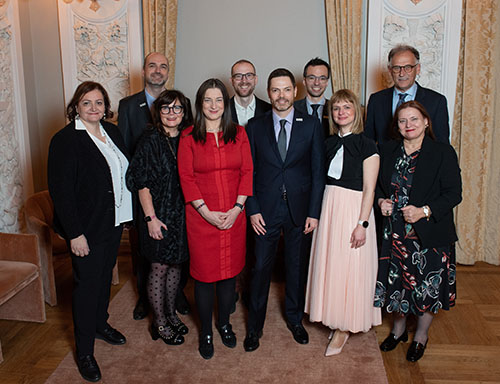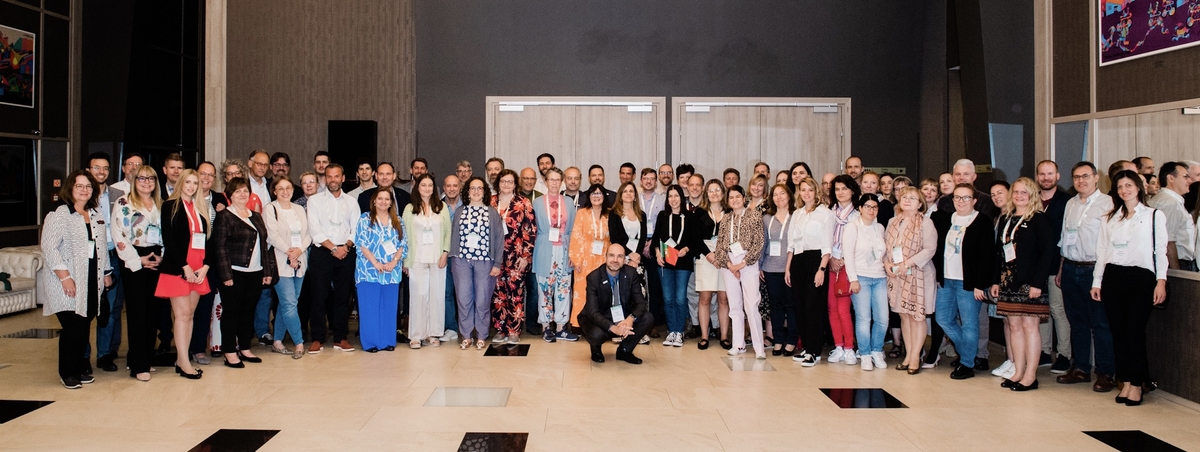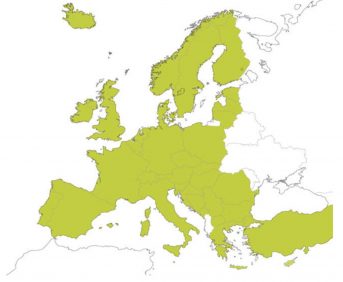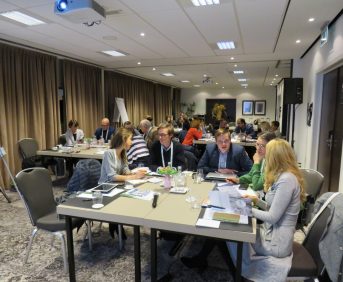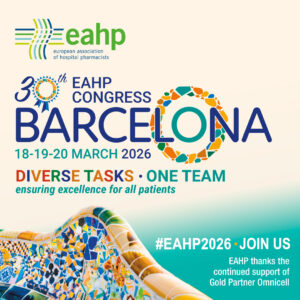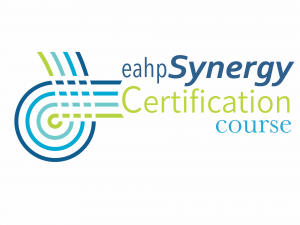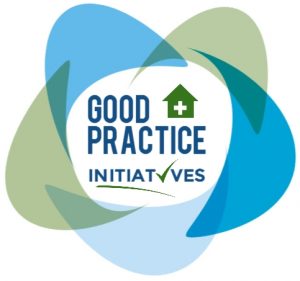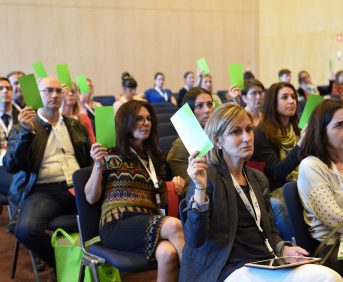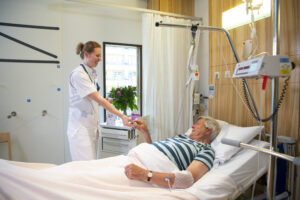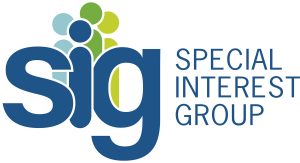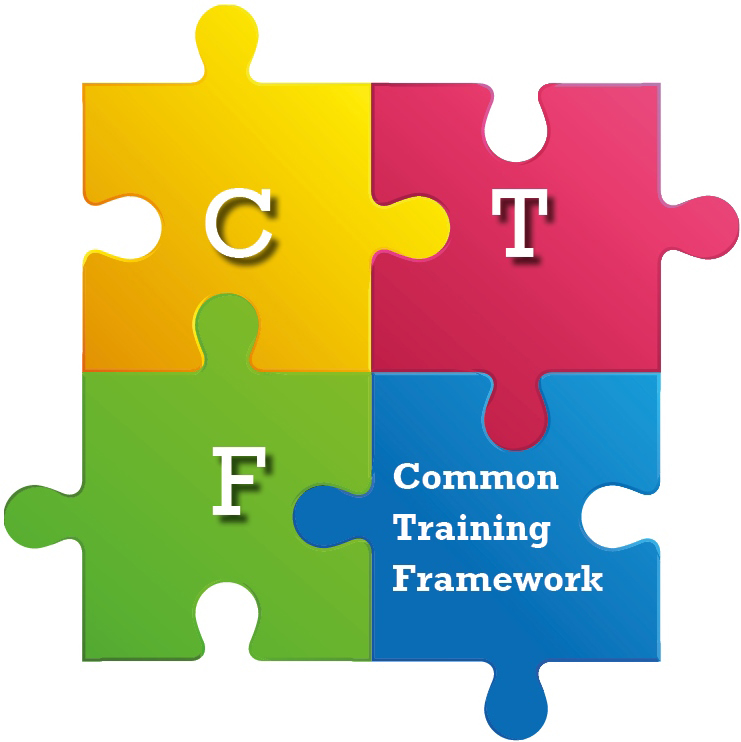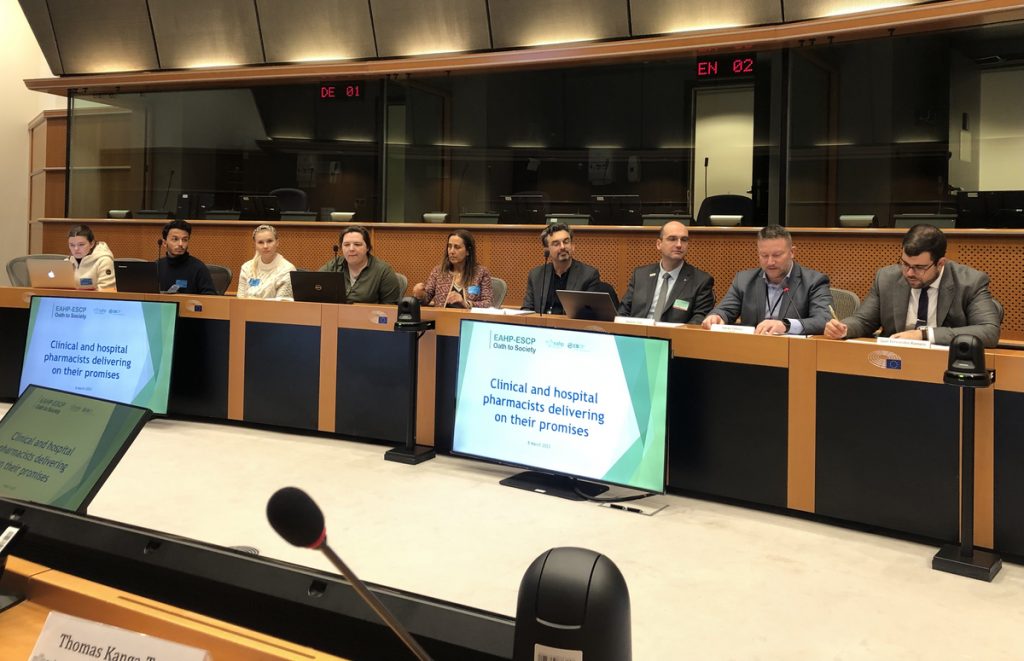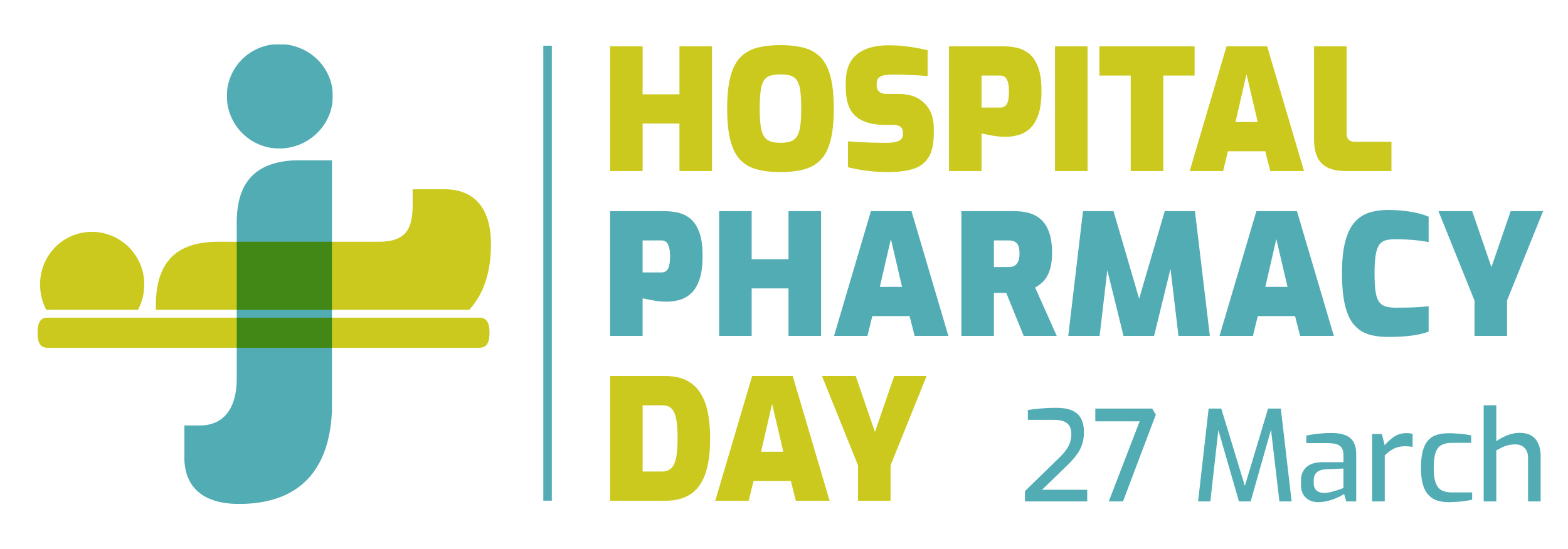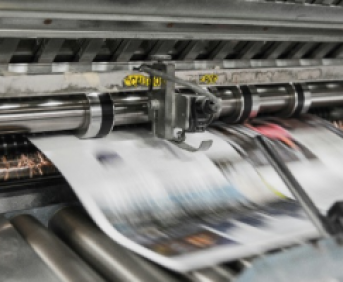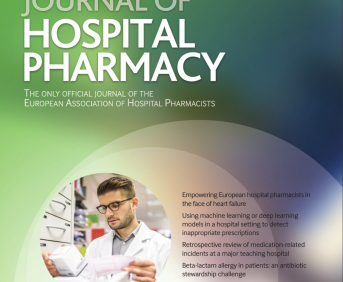HOSPITAL PHARMACY UNIFIES ELECTRONIC STANDARD PRESCRIPTION THROUGHOUT THE REGION
Pdf

European Statement
Patient Safety and Quality Assurance
Why was it done?
The primary aim was to increase patient safety by quality-assuring ESPs and guiding clinicians to rational and safe prescribing. The Central Denmark Region (1.3 million citizens) has five hospitals, each with their own hospital and ward management. ESPs were previously set up and maintained locally, often by clinicians at ward level, resulting in several thousand, and a huge variety of ESPs for the same indication/treatment. Often only small differences separated these, but larger differences were also observed. Both patients and clinicians move around hospitals within the region. Varying ESPs from hospital to hospital confused clinicians and compromised patient safety.
What was done?
The regional Drug and Therapeutics Committee (DTC) commissioned the Hospital Pharmacy, Central Denmark Region to take over management of electronic standard prescriptions (ESP) in the shared Electronic Prescribing System (EPS). The pharmacy was also commissioned to lead the unification of local to regional ESPs, in collaboration with clinical specialists. ESPs are electronic ‘packages’ of one or more prescriptions, set up for treatment of defined conditions/procedures e.g. knee-replacement. When the clinician prescribes an ESP, the predefined prescriptions appear automatically in the patient’s medicines list.
How was it done?
The Hospital Pharmacy highlighted clinical areas/treatments with several variations of the same ESP. The DTC appointed relevant clinicians to work with a pharmacist on unifying these, to one (or more) standardised ESPs, to be used in the whole region. The pharmacist was coordinator for the ad-hoc working groups. After approval by the DTC, these ESPs replaced the existing. If a department wanted an ESP that differed from the regional ESP, this had to be approved by the DTC.
What has been achieved?
Regional ESPs have been approved for:
• Abortion (reduced from 17 to six).
• Helicobacter pylori eradication (reduced from 28 to two).
• Treatment of paracetamol-overdosage.
Many new ESPs have been approved, promoting:
• Safe prescribing of complicated regimes e.g. fosphenytoin loading/maintenance.
• Use of regional formulary drugs e.g. antibiotics for pneumonia/urosepsis.
What next?
We continue to work on other regimes that can be unified e.g. treatment of Wernickes prophylaxis/syndrome and parenteral nutrition. We recently met with pharmacists from two other regions that use the same EPS as us – maybe we can share ESPs nationwide in future.
PHARMACISTS IMPROVE DOCUMENTATION OF DRUG ALLERGIES
European Statement
Patient Safety and Quality Assurance
Author(s)
Mohammed Almeziny, Fahad Alkharji , Ali Alkhudair , Jameel Al Mutairi
Why was it done?
Poor allergies’ documentation may cause harm to the patients, if the concerned medication reaches them. The hospital is planning to implement a new Health Information System, which includes a Computerised Provider Order Entry. However, this is a long-term project, so in order to minimise that risk, the hospital administration gave the pharmacists the privilege to do so. The percentage of documented drug allergies was 14%. The issue of compliance from the medical, nursing and pharmacy staff was a major obstacle in allergies’ documentation. For that reason, the pharmaceutical services initiated an improvement project to enhance allergies’ documentation. it is the responsibility of the physician to document any allergy on the inpatient prescription form (IPPF). On the other hand, it is the responsibility of the nurse to ensure that all information is completed on the IPPF before it is sent to the pharmacy. The role of the pharmacist is to document the patient’s allergy in the pharmacy system.
What was done?
Increase the allergy documentation from 14% to 96%.
How was it done?
The FOCUS PDCA was adopted. Find: It was found that the compliance rate was not satisfactory. Patients might receive a medication that is known to cause an allergic reaction, because the allergy was not documented and communicated with other healthcare providers. Organise: The team consisted of all involved departments. Clarify: Some IPPF may not contain allergies and some pharmacy staff do not document the allergy in the pharmacy system. Understand: The factors that may influence the process were identified, although some healthcare professionals consider the documentation as a time-consuming process. The pharmacy system is an old system which does not support enforcing function. Select: The targeted outcome was 90% within 1 year of its inception, July 2017 to July 2018. Plan: All allergies MUST be assisted, and the pharmacy will act as the enforcing body. Do the plan: All pharmacists were reminded to enforce hospital policies by not accepting any incomplete prescription and document all drug allergies in the pharmacy system. Check: Statistics regarding compliance were presented in monthly meetings to highlight the challenges, difficulty or any serious issue. It is a proactive meeting and members can freely suggest any tools required to improve the situation.
What has been achieved?
There was a significant improvement from 14% to 96%.
What next?
Start e-prescription to enforce the documentation of allergies.
IMPLEMENTING NEW CHEMOTHERAPY COMPOUNDING WORKFLOW USING SEQUENTIAL PDSA CYCLES TO INCREASE PRODUCTION CAPACITY, REDUCE WAITING TIME, IMPROVE RESOURCES UTILIZATION, AND MINIMIZE THE RISK OF ERRORS
Pdf

European Statement
Production and Compounding
Author(s)
A Elsheashaey, A Elshishiny, A Orabi, A Almutairi, A Aboulwafa, H Alobaid, F Dashti, D Saeed, R Yassin, M Salama
Why was it done?
Kuwait Cancer Control Center (KCCC) is the only oncology hospital in Kuwait. Chemotherapy Preparation Unit (CTPU) was unable to meet the increased orders; causing delivery delay and more patients’ waiting time. Moreover; rework and more waste due to defective and faulty processes of current workflow resulting in frequent incident reports of wrong final products dispatched.
What was done?
Shifting to a systematic multi-step production workflow to increase compounding capacity, minimize risk of errors, reduce processing time, and maximize utilization of integrated technological resources.
How was it done?
Using multiple PDSA cycles, a comprehensive educational and practical training was conducted, proceeded by staff rotation with newly trained team. Every three weeks a new pharmacist trained and assigned to CTPU. Raw materials stores were rearranged for better accessibility and diminishing unnecessary staff movement. A staging step as the first independent double-check before the start of compounding, and for assembly of raw materials and supplies required for compounding. A verification Step as the second independent double-check upon compounding, using bar-code scanners, touchscreens and cross-checking with the chemotherapy order to assure the quality and integrity of the finished product. Production workload were restructured over three parallel line of manual stations and one automated preparation unit. Pharmacy Information System (PIS) screens were customized to give a first and second audio-visual alarms after 30 and 45 minutes of transcription time respectively. Chemotherapy sessions appointment system were established to assess the daily chemotherapy compounding needs from CTPU in advance with an incremental increase of production capacity to reach 100~120 patients/day or 180~200 preparations/day.
What has been achieved?
Number of preparation compounded by CTPU was increase by 8%, where more than 43% of preparations were validated to release in less than 30 minutes and approximately 88% of preparations were delivered in less than 45 minutes. Number of preparation by automation was increased by 82%, Furthermore, all production incidences has been completely eliminated after full implementation of final verification and validation step.
What next?
The new workflow has increase the workload capacity with less production errors and zero incident reports. Patient experience was improved by comparable preparation time to other international Pharmacy Workload Unit and average time required per patient visit.
TRAINING NURSING STAFF ON SAFE DRUG ADMINISTRATION IN THE EMERGENCY DEPARTMENT
Pdf

European Statement
Patient Safety and Quality Assurance
Author(s)
Gregorio Romero Candel, Esther Domingo Chiva, Nuria Martinez Monteagudo, Jose Marco del Rio, Marca Diaz Rangel, Francisca Sanchez Rubio, Ismael Perez Alpuente, Eva Garcia Martinez, Ana Valladolid Wals
Why was it done?
The ED is an area where medication errors are common given it´s complexity, the large number of patients with different pathologies, having to make quick decisions with little clinical information and the coexistence of professionals with different training.
The use of intravenous (IV) and high risk drugs, as well as the mixture of two or more intravenous drugs in the same diluent are usual and can lead to medication errors.
We designed an educational program based on a session for nurses of the ED to standardize the use of the most commonly administered drugs and improve patient safety
What was done?
A training session for nursing staff on safe drug administration in the emergency department (ED) was performed
How was it done?
A training session was conducted by the fourth year resident during a two month rotation period in this area. The most common mistakes were presented to nurses based on national studies, as well as techniques for safe administration of drugs. Guides on parenteral administration of the hospital were reviewed with special emphasis on high risk drugs and how to manage them according to the Institute for Safe Medication Practices. We also developed a guide including the most frequent drug incompatibilities and direct intravenous administration of drugs for the ED.
What has been achieved?
The aim of the session was to train personnel at the ED in order to reduce medication errors and promote a safety culture. In turn, the development of guidelines to standardize clinical practice are useful, making information accessible and easy to use. Clinical sessions between departments allow the integration of the pharmacist in other areas.
What next?
We are still working with the ED to increase safety in drug therapy by developing new pharmacotherapeutic protocols (high risk medications protocols, perfusion protocols and new safety guidelines and training sessions). We are also working with more departments at our hospital with the experienced gained
PATIENT SAFETY: INTERVENTIONS TO REDUCE RISKS IN MEDICATION USE PROCESSES
Pdf

European Statement
Patient Safety and Quality Assurance
Author(s)
Nadia El Hilali Masó, Elvira Ramió Montero, Gemma Baronet Jordana, Marina De temple Pla, Paula Montoliu Alcon, Maria Jaume Gaya, Núria Pi Sala, Joan Altimiras Ruiz, Montserrat Pons Busoms
Why was it done?
The confusion between drug names represents a common cause of medication errors due to similarities between trade names and active ingredients or vice versa. Very new drugs coexisting with others that are very well known can easily induce errors in wards, unclear prescription may lead to misunderstanding of prescription.
What was done?
Development and implementation of measures to improve patient’s safety from purchase to drug prescription and administration.When we switch to a new provider maybe forced by drug shortage, we perform a review to avoid medication errors in all dosage forms.If needed, we elaborated alerts (pharmalerts) and newsletters. We applied Tall Man letters (TML) method to manage look-alike and sound-alike drugs, and to reduce prescription errors we elaborated a “Best practices on drug prescription” validated by Commission of pharmacy.
How was it done?
We prepared a formulary online on the intranet where pharmacist introduces relevant drug information as composition (i.e, excipients, contents latex or not, etc.), dilution, stability, source of errors (name, brand name,etc) among others. We compare them with existing ones to take an action, if necessary, that will be spread to all professionals. To implement TML method we followed the ISMP recommendations. First, we selected 3 antibiotics: cefOTAXime, cefAZOLin, cefTRIAXone. We changed these names in the prescription program so that the differentiation is reflected when drugs are prescribed, dispensed and administered. The implementation was explained to pharmacy, nursery and medical staff.After a month, we evaluated its acceptance.
What has been achieved?
We reviewed 61 new products: 50 trademarks, 14 new drugs and 7 dosage forms. 70.48% of products, acquired temporally or permanently, were new trademarks; 19.71% new drugs and 9.81% new dosage forms. The review is a good tool for a safe use of drugs and improves communication between healthcare providers. To evaluate TML implementation 240 questionnaires were completed: Acceptance was 92.05% (nursery and medical staff). 91.17% thought that it is possible to make a mistake with look-alike or sound-alike drugs and 68.72% that TML is useful to minimise medication errors.
What next?
The huge acceptance of TML encourages us to select other drugs from ISMP list. We have 6 pairs of drugs. We are planning to extend its use to storage shelves on wards.
SIMULATION LEARNING PROGRAMME FOR NURSES: A WAY TO SECURE THE PILLBOXES PREPARATION IN THE CARE UNITS
Pdf

European Statement
Patient Safety and Quality Assurance
Author(s)
Charlotte Ménage, Mickaël Le Barbu, Adrien Borowik, Christine Housset, Sandrine Voisin, Florence Lémann, Jean-Michel Descoutures
Why was it done?
An audit of the medication storage cabinets was performed in 2015 in 19 care units. Over a three month period, more than 5000 inappropriate medecines were found which are likely to alter the process of pillboxes prepation by the nurses. Our objective was to develop a training program for nurses to identify and avoid near miss events during the medication administration process.
What was done?
A simulation learning program for nurses was implemented to secure the drug pillboxes preparation.
How was it done?
A multiprofessional team (i.e., pharmacist, physician, pharmacist resident, head nurse, risk manager, hospital hygienist) collaboratively developed a simulation-based workshop. Two mobile cabinets were designed. They were composed of 28 medicine boxes, a patient pillbox and a laptop with a mock prescription. They included the use of a simulation scenario with errors (e.g., expired tablets, damaged blister packs, mixed pharmaceutical forms or dosages, non-formulary drugs). The nurses had to prepare the patient’s pillbox for one day and then were asked to solve five questions about good practices. A validated assessment grid was filled in by two team members, and finally discussed with the nurse about the successes and pitfalls as an education purpose. At the end of the simulation program, nurses had to answer a satisfaction survey.
What has been achieved?
47 nurses experienced the simulation-based workshop. It took 40 min for each nurse on the same week. 89% removed the deteriorated tablets remaining in the pillbox and did not unpack any unit dose. However, 81% were unable to prepare the right medicine, the right dose, the right route for the right patient at the right time, because of a lack of patient identification on the pillbox. Some critical procedures were considered not appropriately followed: i.e., detecting acetaminophen prescription duplicate (only 26%), throwing away medicines in the right disposable bin (21%), checking the tablet expiry dates (70%), using a drug for which the patient was not allergic (62%). The 47 nurses were all together satisfied (100%) with this workshop.
What next?
The simulation based program was adopted by the hospital department of nurse care. It is now integrated in the yearly re-assessment skills program of all nurses.
INTEGRATION OF A PHARMACIST INTO THE EMERGENCY DEPARTMENT
European Statement
Patient Safety and Quality Assurance
Author(s)
PALOMA CRESPO-ROBLEDO, MARIA SEGURA BEDMAR, IRENE ESCRIBANO VALENCIANO, NURIA BLAZQUEZ-RAMOS, BEATRIZ MARTIN CRUZ, CARMEN MORIEL SANCHEZ
Why was it done?
Patient safety is an essential component of quality care. It’s known that EDs are an element of risk for the onset of adverse events due to conditions related to patients’ comorbidity, communication problems, medication errors and working conditions like limited information about the patient, workload, interruptions, shifts, etc. It was detected that reconciliation of medication was not performed; neither validation of the medication prescribed and medications were stocked with no order and control.
What was done?
A project was developed to increase patient safety in the Emergency Department (ED) based on the presence of a hospital pharmacist in the team.
How was it done?
First thing was to review and validate the medication prescribed in patients who were under observation, at the same time performing a reconciliation given their acute situation. This way a relationship between nurses, physicians, patients and pharmacist was established.
Then, electronic prescription software was integrated within the automated dispensing cabinet (ADC), eliminating potential errors choosing the right drug. Only when a pharmacist has checked the medication, the list appears in the display and can be taken out all at once. The main problem has been to agree the stocks and how nurses can return easily and operatively the medication in order to not accumulate it out of the ADC.
What has been achieved?
Pharmacists’ clinical figure is being disclosed in a country where Hospital Pharmacy is a central and close department. In 43 days, 428 patients got their prescription checked in the ED, 346 pharmaceutical interventions were made in 198 patients, a median (IQR) average of 1 (1,2) interventions per patient. The main reason for an intervention was the adequacy to pharmaceutical forms included in the Hospital(n=130), followed by reconciliation interventions(n=77). Category of errors detected were mostly B (NCC MERP), showing pharmacists can detect an error occurred but that did not reach the patient
What next?
Hospital pharmacists should show their clinical and logistic potential, fighting with other health professionals to increase safety and care in patients. ED is the entrance of patients into the health system and where more errors can be committed, the work of a pharmacist should start at ED to prevent errors and give support and be part of the team.
DEVELOPMENT AND IMPLEMENTATION OF “CHECK OF TREATMENT APPROPRIATENESS” IN A LARGE TERTIARY CARE CENTRE
European Statement
Clinical Pharmacy Services
Author(s)
Tine Van Nieuwenhuyse, Sabrina De Winter, Isabel Spriet, Thomas De Rijdt
Why was it done?
During the last decade, healthcare shifted in many ways towards a more patient-focused rather than a disease-focused approach. Hospital pharmacy services experienced a similar development. Traditional drug-oriented services expanded towards patient-oriented services by imbedding computerized clinical decision support (CCDS) in the prescribing process and implementing bedside clinical pharmacy services, both leading to improved efficacy and safety of medication use. However, due to limited resources, clinical pharmacy services are not implemented on a hospital-wide basis in Belgian hospitals.
To guarantee patient safety throughout the hospital, emphasizing patients at risk, we started in March 2016 with the development and implementation of central check of medication appropriateness.
What was done?
Development and implementation of central check of medication appropriateness (COMA) in hospitalized patients in a 2000-bed academic hospital.
How was it done?
Based on a risk analysis, high risk prescriptions are checked by a hospital pharmacist for appropriateness. A daily check (0.5 FTE) of automatically generated queries is performed using standardized algorithms. The queries are a result of the screening of all new prescriptions in the electronic prescribing system of the last 24 hours. If an urgent intervention is necessary, in case of a serious adverse event, a phone call is carried out to the treating physician. In all other scenarios, interventions are performed via electronic warnings in the patient’s file.
What has been achieved?
– Development of 75 specific algorithms covering 5 pharmacotherapeutic areas of interest: drugs with restrictive indication, medication-related biochemical changes, evaluation of overruled interventions raised by CCDS, reimbursement of drugs, sequential therapy for bio-equivalent drugs.
– Education of 8 pharmacist involved in the COMA
– During a 6-month period, 19220 prescriptions were checked for which 8284 (43%) electronic warnings were sent and 224 (1%) phone calls were carried out. When analysed without automatic warnings for sequential therapy, 11751 prescriptions were checked for which 815 (7%) electronic warnings were sent and 224 (2%) phone calls were carried out.
What next?
For the future we obtain next goals:
• Evaluation of the current COMA, with emphasis on improving specificity
• Development of new algorithms , also expanding to other areas of interest
• Development of an easy access training tool for hospital pharmacist to perform COMA
DEVELOPING A PROJECT FOR BROADCASTING INFORMATION ABOUT MEDICATION ERRORS
Pdf

European Statement
Patient Safety and Quality Assurance
Author(s)
Sergio Plata-Paniagua, Alfredo Montero-Delgado, Jose Javier Arenas-Villafranca
Why was it done?
Currently, with the extended use of social-networks (SN), information related to medication errors can be disseminated quickly and directly, and also provide interaction with professionals enhancing the information. This is very important to promote safety culture among health professionals to prevent medication errors.
What was done?
Two hospital pharmacy specialists from two spanish hospitals created a project based on web 2.0 to broadcast information about medication errors and how to prevent them.
How was it done?
First step was to create a website in which we could post information related to medication errors. The main part of the website is the blog, where we develop all information that we consider interesting. The website also has other sections containing useful resources: photo gallery with examples of look/sound-alike drugs, infographics, educational information, information about the authors and a section where readers can share content with the authors.
Second step was to create accounts on SN to spread the information posted in the website and also for sharing original content. We chose Twitter and Facebook as ideal SN. Twitter allows sharing information quickly and concisely and also is used by a different groups of healthcare providers by allowing us a wide spread. On the other hand, Facebook allows us to reach to a different audience, especially patients.
What has been achieved?
-Currently we have more than 16.000 followers on Facebook, 5.500 on Twitter and the website receives more than 3.500 monthly visits.
-Because of the multiple warnings that we have carried out about Look-Alike/Sound-Alike drugs, some pharmaceutical companies have considered changing the packaging of their drugs.
-We have achieved more than 70.000 signatures on change.org website requesting Spanish healthcare authorities to develop guidelines for the proper packaging and labeling of drugs. Because of this initiative, the Spanish press became interested in this problem and our project and the problem of drug packaging was mentioned in multiple media.
What next?
Currently, we have included another pharmacist in our project in order to enhance the quality and periodicity of our publications. On the other hand, we are trying to work together with institutions dedicated to preventing medication errors to carry out joint projects in order to improve patient safety.
